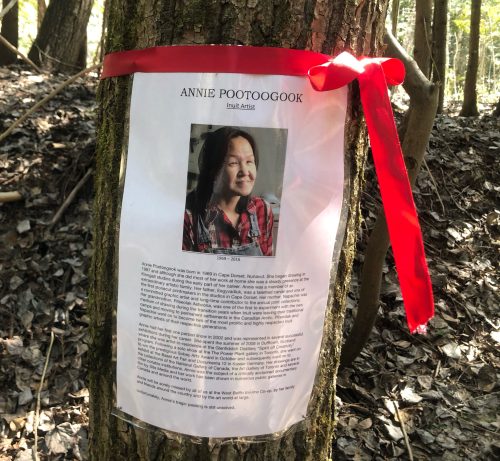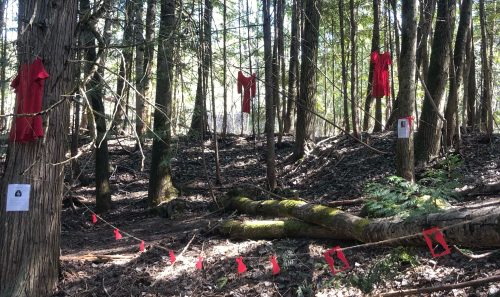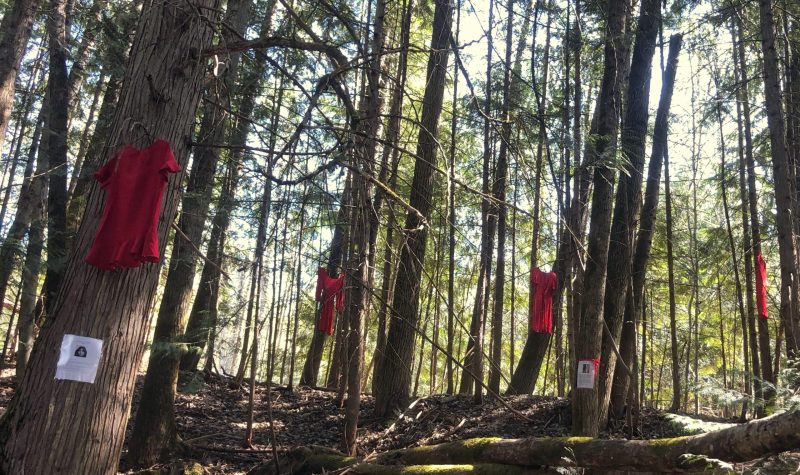Big and small red dresses hang high on branches off a path behind the Revelstoke Railway Museum, 16 of them swaying in the breeze. A stream runs below the trees. It's a cool, peaceful place to contemplate the crisis of missing and murdered Indigenous women, girls and two-spirit people in Canada (MMIWG2S).
Biographies of eight missing or murdered women are attached to tree trunks below the dresses and a few red ribbons are tied around smaller trees.
"These women didn't do anything wrong," said Jessica Stewardson, a member of the Bingwi Neyaashi Anishinaabek band in Northern Ontario, who's now an Indigenous student advocate for School District 19 in Revelstoke.
They were going to school, taking care of their kids—one biography is of Inuk artist Annie Pootoogook whose work is world renowned. Her body was found in the Rideau River in Ottawa in 2016, and the circumstances around her death remain unsolved.

A biography of Annie Pootoogook, Inuk artist whose body was found in 2016. Photo by Meagan Deuling.
Stewardson worked with Nicole Rock from Community Connections Revelstoke Society and the Women's Centre to hang up the dresses and bios. The display is timed to correspond with May 5, which is the National Day of Awareness for Missing and Murdered Indigenous women, girls and two-spirit People, also called Red Dress day. The dresses will stay in the forest until May 26.
The concept of using red dresses to commemorate missing women came from Métis artist Jamie Black, Stewardson said.
Black chose red because she heard it's the only colour that spirits can see.
"When you see it up in the trees with the contrast of the browns and greens, it's really impactful and it's beautiful to see," Stewardson said.
The red dresses are to bring public awareness to the fact that Indigenous women have been going missing in Canada for decades and in most cases no one is being held to account. The biographies are to show that the women were living their lives like anyone else, and the colour red is to show that they're not forgotten.
The government of Canada in 2016 started a National Inquiry into violence against Indigenous women, and in 2017 released the final report. Thousands of people testified during the inquiry, telling how violence has affected them and their families. It's estimated that 1200 women, girls and two-spirit are missing, but the exact number is unknown. The findings lead the commissioner of the Inquiry to call violence against Indigenous women a genocide.
In some cases, women were missing for three weeks before there was a call out or report that they were even missing, Stewardson said.
The red dress display in Revelstoke is this month's district project. There are books and other resources for teachers to prepare students in the classroom, then they can come into the forest, read the biographies, and learn about this part of Canadian society.
Rock and Stewardson hung a string between two tree trunks and attached small red dresses cut out of paper. There is a pile of river rocks by the stream. Students can write message to the women on the dresses and rocks.

A string of paper dresses where people can write messages. Photo by Meagan Deuling.
It's important for children to learn about this part of Canada's reality because they're the next generation, Stewardson said.
"These students will become police officers or judges or lawyers and hopefully with a kinder heart, and racism is not part of their life," she said.
The Revelstoke Women's Centre is also displaying cut out paper dresses in their windows, and other businesses in town are encouraged to do the same to bring visibility and awareness to the women, girls and 2 spirit people.
To find the display go up the Nels Nelson path behind the Railway Museum, and then take a smaller gravel path off to the left. Stewardson and Rock hung up a sign to mark the trail.
"It's just really quiet in here and I think that me and Jessica even had some reflective time when we were putting everything up," Rock said.
"It’s really pretty too if there is a slight wind, it’s like the spirits are dancing. It’s beautiful." Said Stewardson.
Click below to listen to a radio story about the display:


